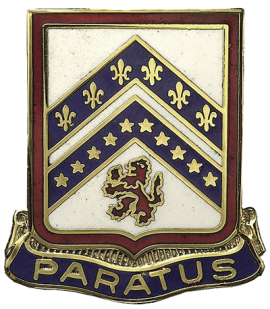As a 17yrs old Pfc in Co F 103rd Engineer Regiment an element of the 28th Infantry Division Joseph L. Begin was born on Sept 24, 1923 in Philadelphia, PA. He enlisted in the U.S. Army on Sept 05, 1940 as a Pvt in Co F 103rd Engineer Regiment an element of the 28th Infantry Division. He was inducted into Federal Service on Feb 17, 1941 and began his training. The next few days were spent with intensive preparations for extended active duty. The days were devoted to physical examinations, inspection and preparation of equipment. After several days of preparation at the armory, the Regiment moved from home station in Philadelphia on Feb 25, 1941, to the Indiantown Gap Military Reservation, where it joined the other organizations of the 28th Division. Camp construction at the Gap was not entirely completed prior to the Regiment’s arrival, and February-March weather in that area was not always favorable for field problems.
However, these situations served to develop the organization’s initiative and ability to meet and overcome difficulties. The preparation of the Regiment for active duty followed the schedules prescribed by higher headquarters and began with basic training for the recently joined personnel, with continuing emphasis on physical conditioning. Programs were developed for small units, larger units, specialist training, and familiarity with equipment all essential to the preparation of the Regiment for its function as an integral component of the division team. The unit at Indiantown, including trucks, graders, tractors, pontoons, H-10 bridging and other special engineer items, Joseph was promoted to the rank of Pfc on Mar 01, 1941. Personnel were trained and qualified in their operation, maintenance, capabilities and limitations.
As there was no suitable body of water at Indiantown, several tactical movements were made to Mt. Gretna to make use of that area’s water facilities for footbridge and floating equipment practice. The preliminary training and field exercises completed at Indiantown, the Regiment moved with the division on Aug 25, 1941 to the A. P. Hill Reservation, near Fredericksburg, Va., for further large unit training and maneuvers. Immediately upon return to Indiantown, the 28th Division and the 103rd Engineers prepared for large-scale maneuvers in the Carolinas with the 1st Army. The division, including the Engineer Regiment, left for the Carolina maneuvers area on Sept 25, 1941 a four-day move, with bivouacs at Winchester, Va., Horse Pens Lake and Greensboro, N. C. The 103rd arrived at base camp near Lilesville, east of Wadesboro, N. C., on Sept 29, 1941. At the close of these maneuvers the Division and attached troops were directed to return to Indiantown Gap. This movement was made as a three-day operation with overnight bivouacs at South Boston, Va., and Warrenton, Va., and arrival at the Gap scheduled for the evening of the third day. The Division moved under the command of the commanding officer, 103rd Engineers. This brought together a great contrast in vehicles from the engineer pontons and heavy road equipment to cavalry horse trailers and the pigeon company’s mobile loft: An army was on the march! The long and cumbersome road unit required early departures and late closings in bivouac areas. The 28th Division and the 103rd Engineers left Wadesboro, N. C., for Indiantown at daylight Sunday, Dec 7, 1941!
That Sunday millions of Americans sat by their radio sets in disbelief that Japan would attack the United States. Japan did attack the United States and it was later disclosed to be a great military disaster. But it also later proved to be a grave mistake on the part of the Japanese. As the long, winding motorized columns trundled toward South Boston, Va., the radio in the control car crackled with the electrifying news that Japanese planes had bombed Pearl Harbor. The excitement of the civilian population was matched by the excitement of the troops when they bivouacked that night near the North Carolina Virginia border. The excitement never dimmed on the remainder of the movement to the Gap. Rumors were rampant during the next several days; orders were received; orders were cancelled. A divisional reconnaissance party, including the Division Engineer, was dispatched on Dec 11, 1941 to the New Jersey coastal area. The mission was to locate concealed bivouacs in the pines southeast of Camp Dix where the entire 28th Division could be placed in position to defend an assigned sector of the New Jersey coast.
Maximum leaves over the Christmas and New Years’ holidays were restricted, and in some cases it was necessary to recall certain personnel after they had already departed from camp. The Engineer Regiment was ordered to assist the Philadelphia District Engineer on protective projects at the Philadelphia, Pa., and New Castle, Del., airports. The work consisted principally of constructing sand bag revetments around planes at these installations. The first battalion was assigned to Philadelphia, the second to New Castle. January 1942 was a tumultuous time. In addition to the problems of this fluid period the 28th Division was reorganized into a Triangular Division, with the engineer component reduced from a regiment to a battalion.
Then on Feb 17, 1942 the 103rd Engineer 2nd Battalion was redesignated as the 180th Engineer Battalion and relieved from assignment to the 28th Infantry Division. The 180th Engineer Battalion, which was divided into three companies: the H&S, Headquarters and Service Company, and two line companies, A and B trained for its primary mission at Plattsburg Barracks, New York and Camp Maxey, Texas. Joseph was reassigned to the H&S Co 180th Engineer Battalion on June 17, 1942 he was promoted to the rank of T/5 on July 06, 1942. On Aug 1, 1942 the 180th Engineer Battalion was redesignated as the 180th Engineer Heavy Ponton Battalion. On Nov 01, 1942 Joseph was promoted to the rank of Cpl, and on Mar 17, 1943 he was promoted to the rank of Sgt. Then on Aug 10, 1943 the rank of S/Sgt, and on Oct 06, 1943 he made the rank of T/Sgt. He was reassigned to Co A 180th Engineer Battalion, Heavy Ponton, on Dec 06, 1943. On Dec 27, 1943 he was reduced in rank to Cpl. The Battalion participated in the Louisiana Maneuvers in February and March 1943.
The Battalion departed from the New York Port of Embarkation on Feb 11, 1944 on the Duchess of Bedford bound for England. It docked at Greenock, Scotland on Feb 22, 1944. During the time in England from Feb 24, 1944 to July 20, 1944, the Battalion was stationed at Congleton, Cheshire, assigned to the Third U.S. Army and trained at Chester, England on the River Dee in the construction of the Floating Bailey Bridge, Fixed Bailey Bridge, and the Heavy Ponton Bridge. The Battalion landed on Utah Beach, France on July 22, 1944 and began to prepare for future operations. It was utilized by Third Army to haul and move Engineer Supplies and equipment needed during the rapid advance across France from July 24, 1944 to Sept 14, 1944.
Joseph Begin and the 180th Engineer Battalion spent the next few months constructing the Floating Bailey Bridges, Fixed Bailey Bridges and Heavy Ponton Bridges until December, when Patton relieved them because the Germans had launched the Ardennes Offensive (known to Americans as the Battle of the Bulge). Patton's army made a spectacular battle march to relieve the 101st Airborne's Screaming Eagles who were holding Bastogne against all odds. The Battalion was reassigned to engage in several hauling missions for Third Army to depots at Bastogne, Arlon, Belgium and Esch, Luxemburg. A reconnaissance of the Moselle River in the vicinity of Remich, Luxemburg was started on Jan 15, 1945 for the location of a suitable site for a bridge. The Third Army Engineers constructed 2,498 bridges with a total footage of 255,520 feet, almost 48 and one half miles of bridging. They built or maintained an average of 2,240 miles of road.
On Feb 6, 1945 the 180th Engineer Battalion was detached from Patton's Third Army and assigned to the Ninth Army. The Battalion built a bridge across the Roer. Then it began stockpiling material at Linford for bridges across the Rhine. Late in March, the Battalion built two bridges across the Rhine. On May 12-13, 1945 Companies A and B built a Heavy Ponton Bridge over the Elbe River, at Magdeburg, Germany. The 180th Engineer Battalion received credit for occupation duty in Germany for the period of May 02, to July 05, 1945. At the end of the war, they were in Osterberg, Germany, which may or may not be where they performed their occupation duties. Joseph Begin was Assistant Unit Foremen of Co A 180th Engineer Bn. In the ETO his unit build Bailey Bridges, Ponton (floating) Bridges, and Timber Trestle Bridges, all while under direct enemy fire.
While performing his occupational duties Joseph Begin was assigned to Co A 552nd Engineer Battalion (Heavy Ponton) on July 02, 1945. Then on July 09, 1945 he was reassigned to H&S Co 602nd Engineer Battalion and again reassigned to Co G 274th Infantry (70th Infantry Div.) on Aug 27, 1945. He returned to the U.S.A on Oct 09, 1946, separated from the U.S. Army on Oct 22, 1945. He served in France, Belgium, Holland and Germany. He received Five Bronze Service Star for participation in the Campaigns of Normandy, Northern France, Ardennes Alsace, Rhineland, and Central Europe. He also received the Army Good Conduct Medal, the American Defense Service Medal, the American Campaign Medal, the European - African - Middle Eastern Campaign Medal, the World War II (WWII) Victory Medal, the Army of Occupation Medal with Germany bar, and the Army Driver/Mechanic Badge With Driver W & A Badge Bars. And the U.S. Army Marksman Badge with Qualification Badge Bars for Rifle, Carbine and Pistol Shooting..
Joseph L. Begin
















